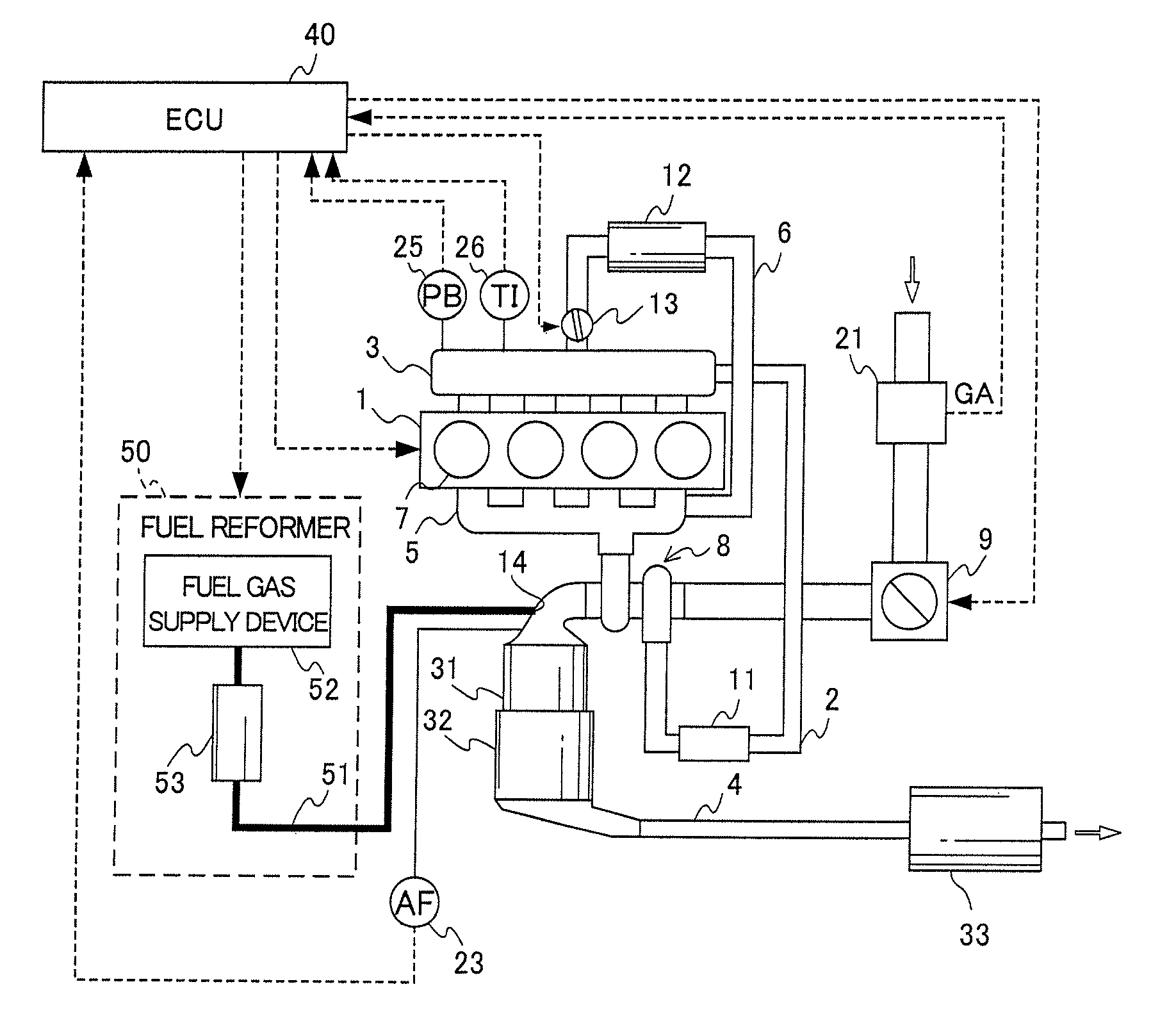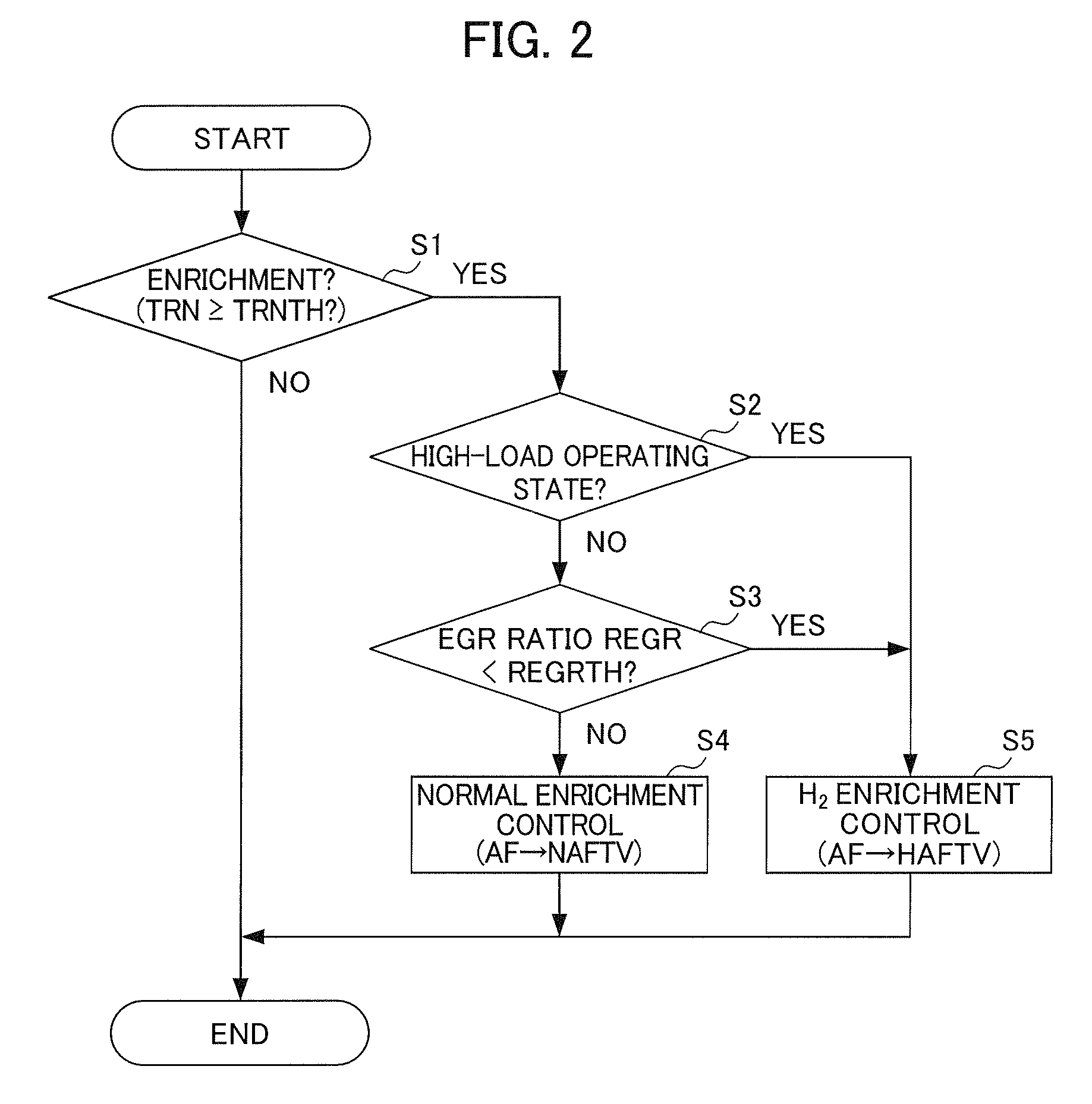Exhaust emission control device for internal combustion engine
a technology for exhaust and combustion engines, applied in electrical control, machines/engines, separation processes, etc., can solve the problems of deteriorating fuel economy, increasing the amount of nox discharging from the lnt along with the increase of nox emission amount, and reducing the efficiency of exhaust recirculation, so as to reduce the time consumed in the sox regeneration process and maximize the exhaust recirculation ratio
- Summary
- Abstract
- Description
- Claims
- Application Information
AI Technical Summary
Benefits of technology
Problems solved by technology
Method used
Image
Examples
first embodiment
[0131]A first embodiment of the present invention is explained below while referring to the drawings.
[0132]FIG. 1 is a view showing a configuration of an internal combustion engine and an exhaust purification device thereof according to the first embodiment of the present invention. An internal combustion engine (hereinafter referred to as “engine”) 1 is a diesel engine that directly injects fuel into the combustion chamber of each cylinder 7, and fuel injectors, which are not illustrated, are provided to each of the cylinders 7. These fuel injectors are electrically connected by an electronic control unit (hereinafter referred to as “ECU”) 40, and the valve-open duration and the valve-close duration of the fuel injectors are controlled by the ECU 40.
[0133]The engine 1 is provided with intake plumbing 2 in which intake air flows, exhaust plumbing 4 in which exhaust gas flows, an exhaust-gas recirculation path 6 that recirculates a portion of the exhaust in the exhaust plumbing 4 to ...
example
[0193]In the model gas of the Example, model gas having the below composition was used as gas simulating the gas to which the reductive gas (containing carbon monoxide, hydrogen, and hydrocarbons) produced by the fuel reformer according to the above-mentioned embodiment to the exhaust has been added.
[0194]
Lean AtmosphereNO:90ppmCO:6000ppmHC (propylene):500ppmC (C3H6)O2:6%CO2:6%H2O:7%N2:balance gasH2:5000ppmSV = 50000 h−1Rich AtmosphereNO:90ppmCO:2.1% HC (propylene):500ppmC (C3H6)O2:0%CO2:6%H2O:7%N2:balance gasH2:6000ppmSV = 50000 h−1
second embodiment
[0199]A second embodiment of the present invention is explained below while referring to the drawings. In the explanation of the second embodiment below, constitutional requirements identical to the first embodiment are assigned the same reference symbol, and explanations thereof are omitted or simplified.
[0200]FIG. 6 is a view showing a configuration of the engine 1 and the exhaust purification device thereof according to the second embodiment of the present invention. The second embodiment is mainly different from the first embodiment in the configuration of a fuel reformer 50A and the configuration of an ECU 40A.
[0201]In the present embodiment, the fuel reformer 50A is connected into the exhaust plumbing 4 upstream of the NOx purification catalyst 33. In other words, reductive gas produced by the fuel reformer 50A is supplied from an inlet 14A formed in the exhaust plumbing 4 upstream of the NOx purification catalyst 33 into the exhaust plumbing 4.
[0202]An exhaust temperature sen...
PUM
| Property | Measurement | Unit |
|---|---|---|
| temperature | aaaaa | aaaaa |
| reduction reaction rate | aaaaa | aaaaa |
| pressure | aaaaa | aaaaa |
Abstract
Description
Claims
Application Information
 Login to View More
Login to View More - R&D
- Intellectual Property
- Life Sciences
- Materials
- Tech Scout
- Unparalleled Data Quality
- Higher Quality Content
- 60% Fewer Hallucinations
Browse by: Latest US Patents, China's latest patents, Technical Efficacy Thesaurus, Application Domain, Technology Topic, Popular Technical Reports.
© 2025 PatSnap. All rights reserved.Legal|Privacy policy|Modern Slavery Act Transparency Statement|Sitemap|About US| Contact US: help@patsnap.com



